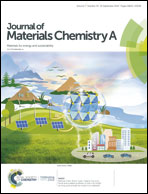Achieving high energy density in a 4.5 V all nitrogen-doped graphene based lithium-ion capacitor†
Abstract
High energy and high power lithium-ion capacitors (LICs) are recognized as one of the most promising energy storage systems for electric vehicles and intelligent grid applications. However, the absence of active materials with large specific capacities and matching reaction kinetics for both cathode and anode greatly restrict the improvement of electrochemical performance. In this work, a 4.5 V “dual carbon” LIC device is constructed, which is based on a thorough investigation and understanding of the synthesis–structure–performance correlations for the graphene nanostructures, by tuning their synthetic chemistry (activation, nitrogen-doping or a combination of the two). The specially designed three dimensionally (3D) porous nitrogen-doped graphene sheet (N-GS) and 3D porous activated nitrogen-doped graphene sheet (A-N-GS) demonstrated large charge storage capacities and superior rate capabilities, as well as outstanding cycling stability, as the binder-free anode and cathode, respectively, because of their hierarchically porous structures, highly conductive networks and heteroatom doping. Benefitting from the matching of the good electrode kinetics, the optimized A-N-GS//N-GS LIC device could achieve an ultrahigh energy density of 187.9 W h kg−1 at a power density of 2250 W kg−1, as well as maintaining a capacity retention of 93.5% after 3000 continuous cycles at a current density of 2 A g−1, greatly outperforming previously reported LICs in the literature. Even at a high power density of 11 250 W kg−1, the device could still deliver an energy density of 111.4 W h kg−1.



 Please wait while we load your content...
Please wait while we load your content...